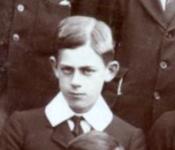
War Memorial
| Captain Anthony Whitelock TURNER MC | |
|
6th (Service) Battalion Duke of Cornwall’s Light Infantry Date of birth: 15th April 1890 Date of death: 6th February 1975 Died aged 84 Buried at St Mary the Virgin Churchyard, Speen |

|
| Anthony Whitelock Turner was born at Colton Rectory in Norfolk on the 15th of April 1890 the only son of the Reverend Henry Whitelock Turner MA DP, Rector of Colton, and Blanche Beatrice (nee Coaks) Turner of Colton Rectory. He was christened at Colton on the 13th of May 1890. He was educated at Hazelwood School until December 1903 where he was a member of the Cricket XI in 1902 and 1903 and was a member of the Football XI in 1902 and 1903 when he was Captain. The school magazine wrote the following of his 1902 cricket season: - "A useful slow bowler, an improved bat, and fairly safe catch." Of his 1903 cricket season they wrote: - "Has improved immensely as a bat and is a good steady bowler, but has imitated the growing fashion of bowling no balls. A fair field and safe catch." They wrote of his 1902 football season: - "(Right half) - Somewhat clumsy, but has pace, and makes good use of his weight. An untiring worker." And of his 1903 season: - "(Captain. Right half) - A very hard worker, but his health has not been of the best, and so he appeared to be somewhat lacking un stamina; apt to be rather easily tricked by a clever forward." On leaving the school the magazine wrote the following on him: - "....goes to Wellington. he has been a very useful member of the Cricket and Football Elevens." He went on to Wellington College where he was in Mr. Brougham’s House from January 1904 to July 1908. He was a member of the Racquet VIII in 1907. He went on to Trinity College Cambridge in 1908 where he obtained a BA on the 17th of June 1911. On leaving university he worked as a land agent's assistant. Following the outbreak of war he applied for a commission in the Cavalry at the Northern Cavalry Depot, Scarborough on the 15th of August 1914. At a medical examination, which was held at Richmond, Yorkshire on the same day, it was recorded that he was five feet ten and half inches tall and that he weighed 146lbs. He did not receive a satisfactory response to his application for the cavalry so he applied instead for a commission in 6th Battalion Duke of Cornwall’s Light Infantry on the 17th of September 1914 and was commissioned as a 2nd Lieutenant in the battalion on the 29th of September 1914. He embarked for France in June 1915. On the 25th of July 1915 half the battalion was holding trenches near Hooge in the Ypres Salient, having begun their tour of the front line on the 18th of July. At around 2pm the Germans began heavy shelling of the British front line during which Anthony Turner suffered a wound between the shoulder blades when he was hit by shrapnel. He was evacuated from Rouen on the 28th of July 1915 and landed at Southampton the following day. A Medical Board sat at the 4th London General Hospital on the 30th of October 1915 to report on his progress: - "He is suffering from the effects of a shrapnel wound in France on July 25th 1915; the 3rd and 4th dorsal vertebrae are out of alignment. There has been inflammation of these two vertebrae above: and pressure on and irritation of the neuro on the right side. The movements of the spine are still defective, and for these he is having massage and spinal movements. The pain is now greatly improved." A Medical Board sat at Wareham Camp on the 23rd of November 1915 which concluded that he was "completely recovered from his wound." He returned to the front. On the afternoon of the 18th of August 1918 the 6th Battalion Duke of Cornwall's Light Infantry was detailed to make an assault on enemy held positions at Delville Wood on the Somme. The battalion was to attack at 2.45pm with B Company and one platoon of A Company on the right and with D Company on the left. An intense bombardment by the supporting artillery began at 6am and continued until 2.45pm when the nearby field guns joined in to intensify the barrage until 2.50pm. Under the cover of the intense barrage the leading men took their objectives, although D Company suffered badly from an enemy machine gun position on the left. With the objective taken the remaining three platoons of A Company immediately crossed no man's land to join them. At 3pm, C Company, who had been in reserve, also crossed over. After heavy fighting throughout the day, by 6pm only the right of the enemy line was still being held by the battalion's bombers. The battalion held this line during the following day and were shelled intermittently, although from 7.30pm to 9pm they were shelled heavily which caused a few casualties. They were relieved at 4.30am on the morning of the 20th of August by the 8th Battalion Rifle Brigade. Anthony Turner was wounded during the initial attack and was evacuated from Boulogne on board the Hospital Ship "Stad Antwerpen" on the 23rd of August, landing at Dover later the same day. A Medical Board, which sat at the War Office on the 23rd of August 1916, reported that: - "He is suffering from shrapnel wound back of left thigh. Fragments still in wound. Also from superficial wound back of right wrist nearly healed." For his actions at Delville Wood he was awarded the Military Cross, which was announced by the War Office on the 20th of October 1916. The citation read:- “For conspicuous gallantry in action. Though wounded in two places he continued to fight and encourage his men in clearing the enemy’s trench and organising the position. He personally accounted for 12 of the enemy”. On the 17th of October 1917 the battalion was at Sanctuary Wood in the Ypres Salient waiting to move into the front line trenches where they were to relieve the 10th Battalion Durham Light Infantry the following day. They spent the day carrying supplies of rations and duck boards forward to the Durham men. During the day Anthony Turner was wounded once again and was evacuated from Boulogne on the 8th of November 1917. He landed at Dover later the same day from where he was taken to the American Women's Hospital at 98 Lancaster Gate in London. A Medical Board which sat at Caxton Hall on the 17th of December 1917 described his injuries: - "That in action he was wounded by a bullet which caused a glancing wound to front of left patella and a communicated fracture of that bone. On the same day in France the wound was cleansed and the fragments of the patella sewn together in aponeurosis. X-ray showed all bones in good position." In all he was wounded four times during the war and suffered with a stiff knee joint thereafter. During the latter part of the war he worked as a Staff Captain at the War Office and relinquished that appointment on the 16th of November 1919, the day he was demobilised at an Officer's Dispersal Unit in London. On leaving the army he moved to Travancore as a tea planter, returning in 1921 when he worked as Resident Land Agent for Sir Alexander brown Bart. and lived at Holmwood near Dorking in Surrey. He devoted himself to estate work and poultry farming. In 1927 he moved to Salisbury where he worked for S.R. Christie Miller until 1933. In 1934 he went to work as a land agent for the Earl of Bathurst at Cirencester Park. During the Second World War he served as Special Constable 2277 in the Gloucestershire Police. He was married by his father at Christ Church, Lancaster Gate to Moira Emmeline Addis (nee McArthur) on the 26th of March 1918; they had a daughter, Sybil M, born in 1919 and they lived at Oakley Cottage, Tetbury Road, Cirencester. He was married for a second time in 1973 to Dorethea Margaret (formerly MacDonald) and they lived at White Lodge, Speen, Newbury in Berkshire. He died after a short illness on the 6th of February 1975. His funeral was held at St Mary's the Virgin Church, Speen at 2.30pm on the 11th of February 1975. |
|
| Went on to Wellington College |
Back